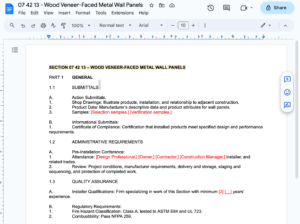Who should write your 3-part specs?
When it comes to crafting a specification for a building product manufacturer, the question of who should write your 3-part specs is a critical one. After a decade of experience in the field, we’ve noticed a prevalent issue: many manufacturers either lack downloadable specs on their websites or present poorly written documents that fail to assist design professionals. Today, let’s explore this topic to gain a better perspective.
You might be thinking, “We’re a big brand, and we’ve got it all figured out,” or “We already have a spec, so this doesn’t concern us.” Unfortunately, the size of your company, the number of engineers on staff, or experienced architectural reps do not automatically make you an expert in spec writing.
With a touch of humor, we’ll identify who should not be entrusted with writing your three-part guide specifications.
Understanding CSI 3-Part Guide Specifications
First, let’s clarify what is a 3-part guide specification for building product manufacturers. It’s a a type of specification tailored to your building product. Sometimes referred to as a “basis of design” or “proprietary specification” its purpose is to provide architects, engineers, and other construction professionals with detailed and accurate information about your product when they are specifying materials for their construction projects. Saving valuable time and research.
A specification consists of three parts based on the Construction Specification Institute principles:
Part 1 – General: This section contains submittals, mock-ups, quality assurance, warranty, and other pertinent information.
Part 2 – Products: This part dives into the specifics of your product, encompassing physical characteristics, performance data, and installation requirements. It may also include information about materials, accessories, and fabrication.
Part 3 – Execution: In this section, you’ll find product installation, testing and inspection requirements. It might also touch on maintenance and repair procedures. However, it should not dive into means and methods of installation, as this falls within the contractor’s domain.
Now, let’s identify the individuals or groups who should steer clear of spec writing:
1. Your Website Company: While your web development team may excel at making your website look impressive, writing construction specifications is a different ballgame. These documents are highly technical and tailored for design professionals, making website developers ill-suited for the task.
2. The Technical Team or Engineer: While technical staff possess in-depth knowledge about your product, but often they hit the common pitfall of overloading your specs with technical information that is counterproductive. Also, a habit of making Part 3 (Execution) excessively lengthy. Product submittals during construction will cover these technical aspects; there’s no need to include them in your company’s specifications. Remember, means and methods of installation are the contractor’s responsibility.
3. The Company Owner: While an owner may want to save on costs by writing specs personally, there’s a specific structure and content required in specifications. Owner-written specs often deviate from the norm, becoming overly wordy technical brochures that fail to meet the needs of design professionals. Also, they often fall in love with their work, so talking them into a rewrite is nearly impossible.
4. The Product Manager: Product managers are usually swamped with marketing-related tasks, leaving little time for writing detailed specifications. Even when they do find the time, the result is often a subpar document that lacks the depth and breadth needed to specify the product adequately. Most often they’re focused on moving the specifications task to the completed box.
5. The New Architectural Rep: New architectural representatives, while enthusiastic, typically lack the expertise required to develop comprehensive specifications for an entire product line. Their primary focus is on project requests, supplying data sheets, BIM files, CAD files, and editable specifications, rather than creating 3-part guide specifications.
Common Specification Pitfalls to Avoid:
Before concluding, let’s highlight some common pitfalls that manufacturers should steer clear of when creating 3-part specifications:
- Not adhering to the 3-part format.
- Over-specifying products.
- Poor page formatting and styles.
- Neglecting guide notes on options.
- Excessive specification writing.
- Specifying means and methods.
- Copying a competitor’s poorly crafted spec.
- Letting the specification become outdated.
- Being overly verbose, resulting in overly long documents.
Writing CSI 3-Part Specs
It all starts with a specification plan and how a design professional specifies the product on a project. Hiring a professional specifier will save you time and provide you with valuable insight into your go-to-market strategy. Plus, you won’t need to figure out all the ins and outs of the Construction Specification Institutes (CSI) formats and principles of writing proper specifications.



